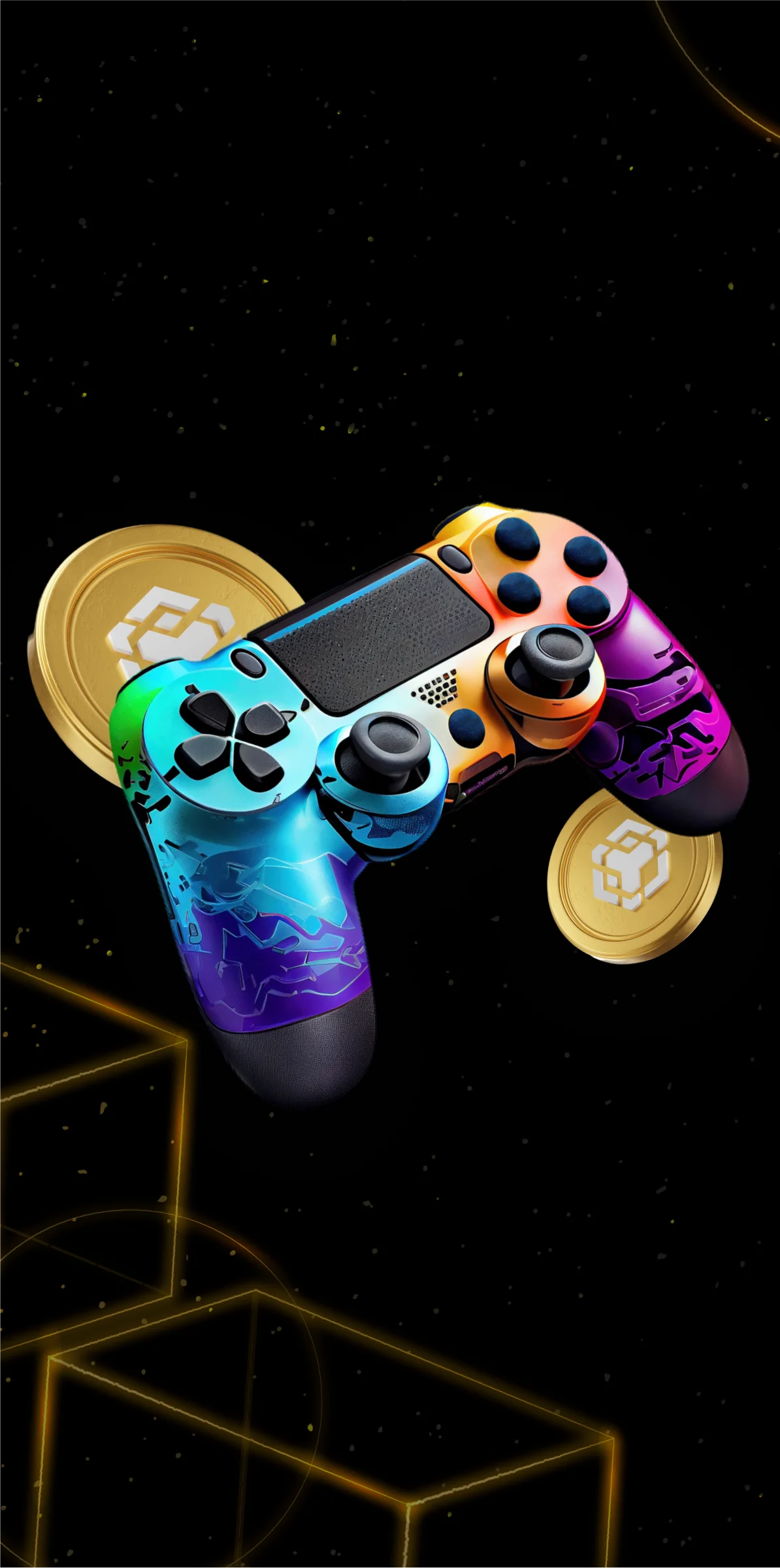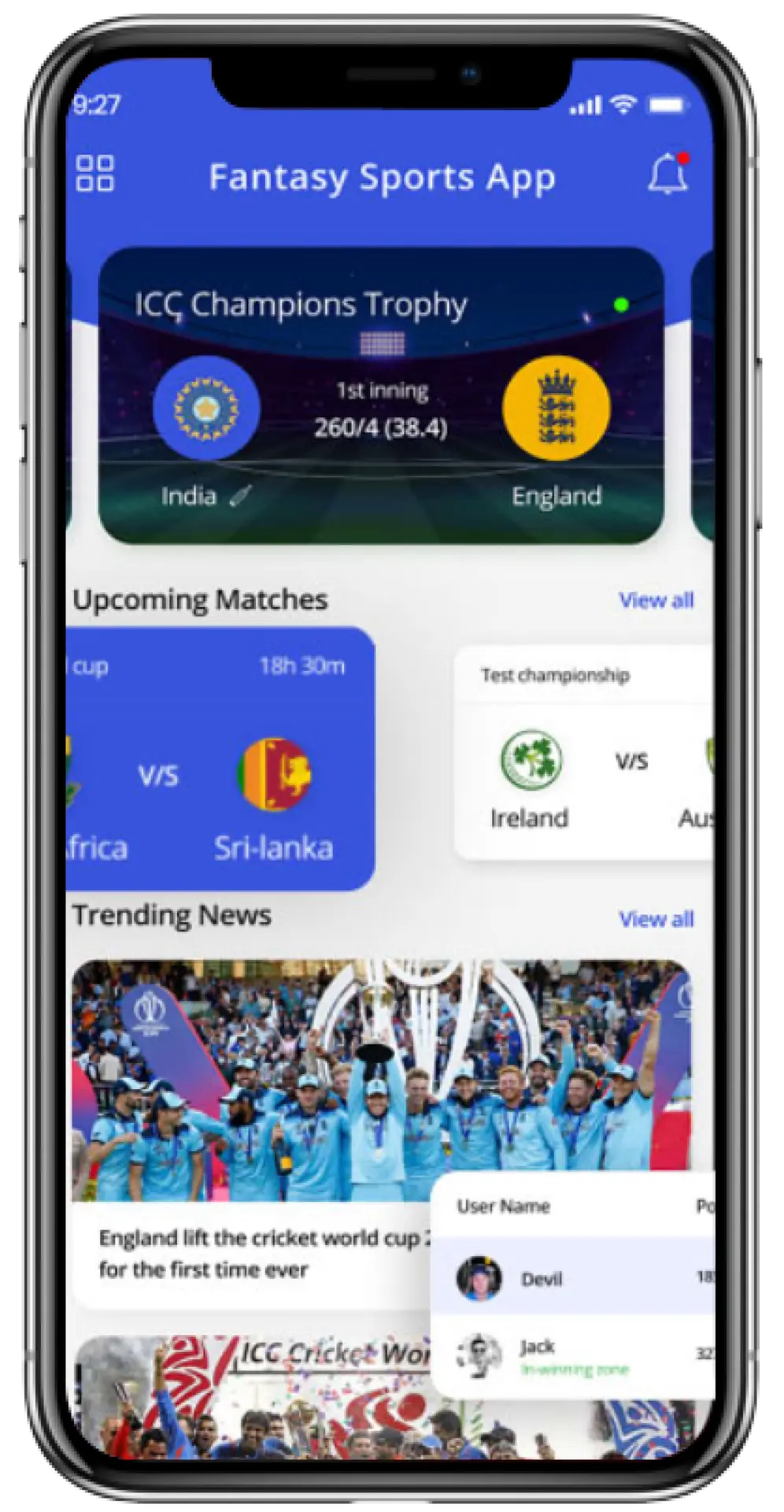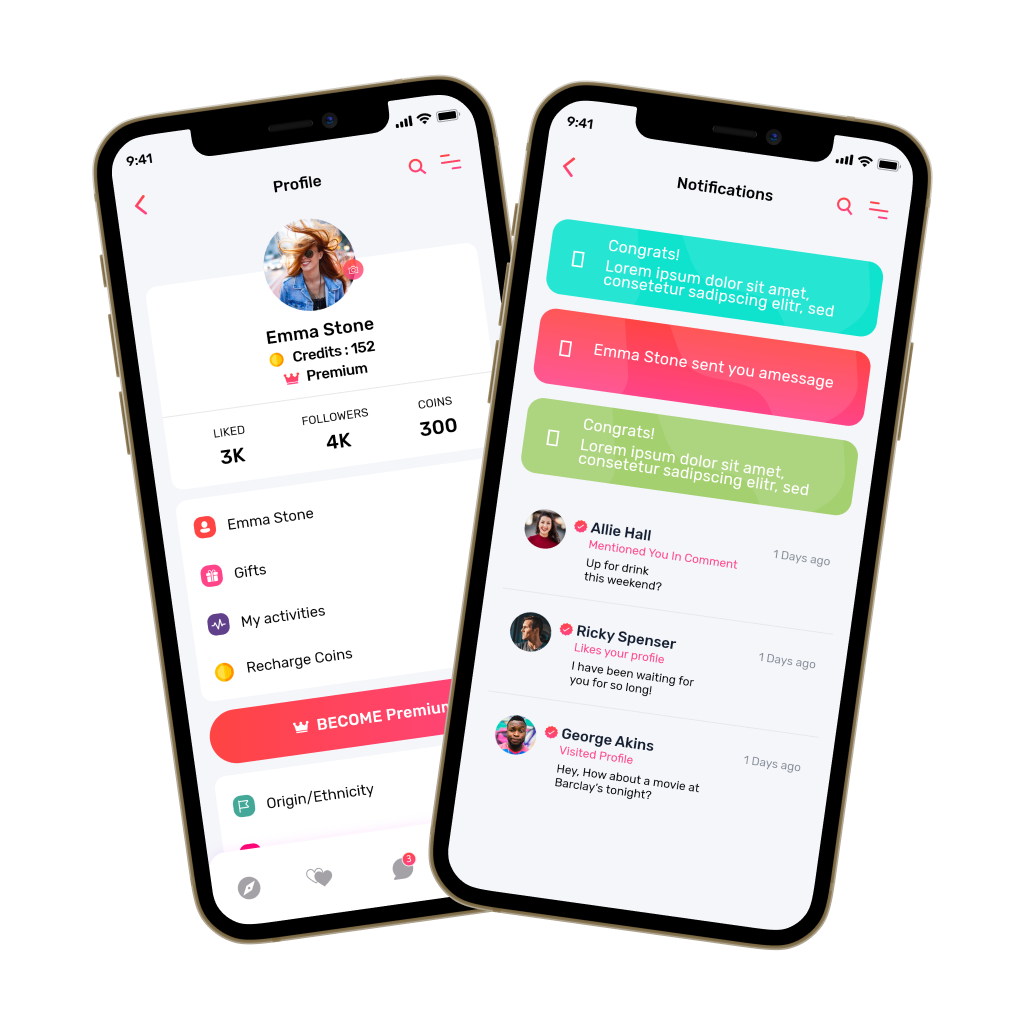Young children learn best when play and education blend naturally, but not every digital experience strikes that balance. Parents look for apps that feel safe, enriching, and age-appropriate, while kids simply want something fun and engaging. That’s why creating a kids’ gaming learning app like PBS Kids Gaming delivers trusted educational content, familiar characters, and playful activities that keep kids learning without even noticing.
They combine thoughtful pedagogy with intuitive, child-friendly technology. Interactive games, adaptive learning paths, gentle guidance, and offline-friendly features help create an environment where kids can explore confidently. Meanwhile, secure architectures, COPPA-compliant design, and clean navigation ensure parents feel just as comfortable as their children.
In this blog, we’ll explore how to build a kids’ gaming learning app similar to PBS Kids Games, covering key features, learning design principles, the technology stack, and safety requirements. With IdeaUsher’s expertise supporting the development and launch, you get a clear roadmap for creating an engaging, educational, and parent-approved app that kids love.
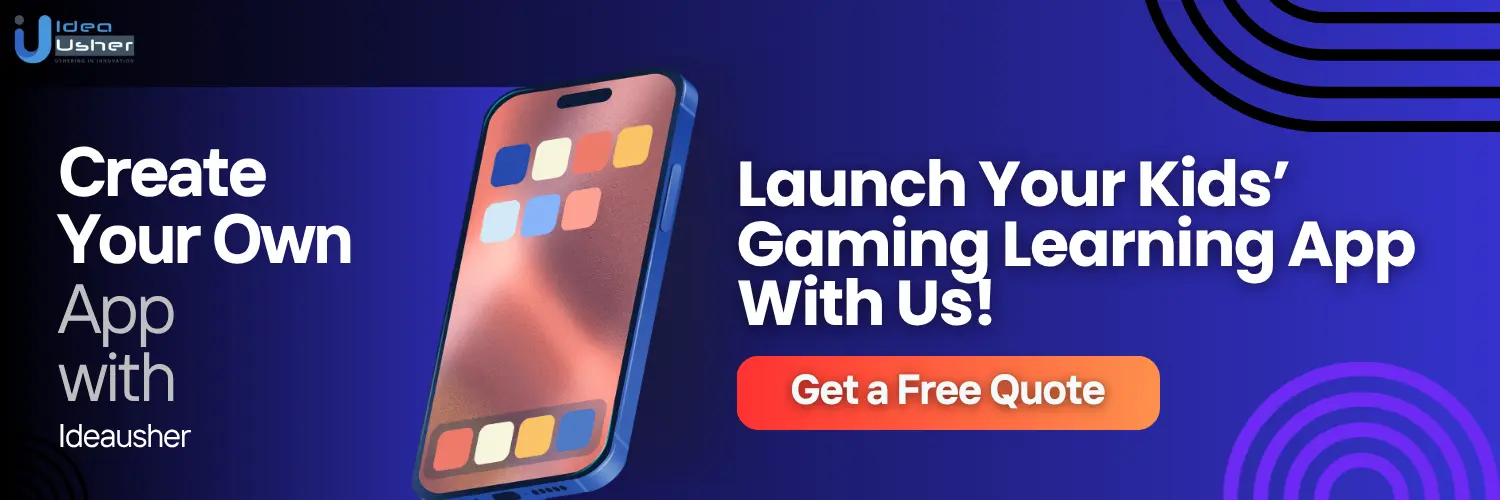
What is Kids’ Learning App, PBS KIDS Games?
PBS KIDS Games is a free, child-safe learning app for preschoolers and early elementary children (ages 2–8). Created by PBS KIDS, a trusted children’s education brand, it offers a wide range of curriculum-aligned educational games in reading, math, science, creativity, and social-emotional skills. With an ad-free, simple, character-based design, it provides a secure environment for children to explore, play, and learn independently.
This app uses play-based learning, familiar characters, and interactive activities to make early education fun and accessible. Its offline games, created with educators and child-development experts, meet early-childhood standards, ensuring age-appropriate and engaging content.
- Wide library of 100+ educational games covering early reading, math, science, creativity, and social-emotional learning.
- Character-driven engagement using beloved PBS KIDS shows like Daniel Tiger’s Neighborhood, Wild Kratts, Sesame Street, and Arthur to boost motivation.
- Completely ad-free and child-safe, making it ideal for parents seeking secure digital experiences for young children.
- Offline play support, allowing kids to download and enjoy games without continuous internet access.
- Content reviewed by educators and early-childhood experts, ensuring lessons align with developmental expectations and learning standards.
- Regular content updates, with new games added frequently to keep the experience fresh and engaging.
- Bilingual support in many games, helping children build basic English and Spanish skills.
- Strong brand trust, backed by PBS KIDS’ long-standing reputation in early education and child development.
Business Model
PBS KIDS Games follows a public-service, accessibility-focused business model designed to deliver high-quality educational content to young children at no cost. Instead of relying on direct monetization, the app prioritizes reach, trust, and early-learning outcomes.
- Mission-driven educational approach focused on delivering free, curriculum-aligned learning experiences for ages 2–8.
- Ad-free and fully child-safe platform, reflecting PBS’s commitment to responsible, ethical digital learning environments.
- Strong integration with PBS KIDS TV ecosystem, using familiar characters to increase engagement and brand continuity.
- Content developed with educators and experts, ensuring lessons meet early-childhood learning standards.
- Wider ecosystem strategy, where the app reinforces PBS KIDS programming, online content, and educational goals.
- Supported by nonprofit funding and grants, allowing PBS to prioritize educational impact over commercial monetization.
- High accessibility through free access, encouraging large-scale adoption among families, schools, and communities.
Revenue Model of PBS KIDS Games
PBS KIDS Games operates on an indirect revenue model, where sustainability comes from the broader PBS ecosystem rather than from app purchases or ads. This allows the app to remain completely free for families.
- Public funding and educational grants, including early-learning initiatives like Ready to Learn, which support app development and content creation.
- Licensing and merchandising revenue from PBS KIDS characters featured across toys, books, games, and educational products.
- Sponsorships and partnerships with organizations aligned with children’s media, literacy, STEM education, and public service objectives.
- Cross-platform engagement benefits, where the app drives attention toward PBS KIDS shows, online content, and associated merchandise.
- Occasional premium or paid standalone apps, showing PBS’s ability to offer optional paid experiences while keeping the core games app free.
- Brand extensions and educational products, which indirectly support the ecosystem that funds and sustains the app’s operations.
What Makes PBS KIDS Games Unique Compared to Other Kids’ Learning Apps?
Understanding what sets kids’ gaming learning app PBS KIDS Games apart helps entrepreneurs identify the success factors behind top-performing children’s apps. These insights reveal where new apps can differentiate, innovate, and compete effectively in the early-learning market.
| Unique Strength of PBS KIDS Games | What It Means for New App Builders |
| Completely free, ad-free, child-safe platform | Shows that offering high trust and zero monetization friction can grow user adoption fast, especially for early-learning markets. |
| Backed by a trusted educational brand (PBS KIDS) | Highlights the power of brand credibility. New apps must build trust through partnerships, expert content, or strong educational positioning. |
| Access to iconic characters (Daniel Tiger, Curious George, etc.) | Demonstrates the value of strong IP. Founders can explore character licensing, original mascots, or storytelling elements to boost engagement. |
| Content developed with educators & child-development experts | Suggests that expert-backed, curriculum-aligned content increases parent confidence and improves app quality. |
| Strong emphasis on SEL (social-emotional learning) | Shows a market opportunity. Most coding/learning apps underdeliver on SEL, so adding SEL-friendly modules can be a differentiator. |
| Offline play support for equitable access | Indicates that making your app offline-friendly improves accessibility and adoption, especially for families with inconsistent internet access. |
| Integrated ecosystem (TV + Web + App) | Demonstrates the impact of multi-platform synergy. New apps can replicate this through YouTube content, blogs, or companion resources. |
| Nonprofit-backed funding model | Suggests alternative sustainability strategies like grants, partnerships, donations, or educational collaborations, not just subscriptions. |
| Large, frequently updated game library | Shows how continuous content updates increase retention and prevent user fatigue. |
| Focused on ages 2–8 with age-appropriate UX | Suggests targeting a specific age segment instead of trying to serve everyone. This improves content depth and app usability. |

Why 84% Higher Participation Signals Strong Growth for Game-Based Learning Apps?
The global game-based learning market size is projected to reach USD 77.4 billion by 2032, up from USD 14.0 billion in 2023, growing at a powerful CAGR of 21.6% from 2023 to 2032. This surge reflects a worldwide shift toward digital, interactive learning experiences for early learners and school-age children.

Supporting this growth, studies show that 84% of students using educational games report higher participation, proving that game-based learning drives stronger engagement than traditional methods.
A. Why Game-Based Learning Drives Higher Engagement?
Game-based learning transforms lessons into interactive activities that naturally capture and maintain children’s attention.
- Digital game users demonstrate higher engagement and better recall, according to Cambridge English research.
- Classrooms using interactive learning tools remain 93% on-task, far above traditional teaching environments.
- Animations, rewards, and hands-on interactions increase intrinsic motivation and reduce boredom.
- Game cycles support short attention spans, helping children stay focused through small, achievable tasks.
- Engagement benefits extend across multiple age groups, making the model successful for diverse learners.
B. How Game-Based Learning Improves Learning Outcomes?
Games help children learn more effectively by allowing them to explore concepts through interaction and repetition.
- Meta-analysis shows medium to large cognitive gains (g = 0.46) in early learners.
- 80% of students demonstrate stronger retention compared to traditional instruction.
- Emotional and social development improves significantly (g = 0.35 and g = 0.38).
- Puzzles and challenge-based missions strengthen problem-solving and critical-thinking skills.
- Children revisit lessons voluntarily, reinforcing long-term skill development.
C. Increasing Teacher Adoption Strengthens Market Growth
Educators are increasingly integrating game-based learning into classrooms due to its measurable impact.
- 74% of teachers now use digital game-based tools to improve engagement.
- Teachers report noticeable improvements in confidence and participation among struggling learners.
- Gamified tools support multiple learning styles, improving inclusivity.
- Classrooms see better energy levels and smoother transitions between lessons.
- Higher teacher adoption boosts institutional demand for educational apps.
The insights clearly show that game-based learning is highly effective for early education. Children stay more engaged, retain concepts better, and respond positively to interactive, play-driven experiences. With teachers and parents increasingly embracing digital learning tools, the demand for high-quality, child-safe educational apps continues to rise. For anyone planning to launch a kids’ learning app, these findings confirm a strong and growing opportunity for impactful, skill-building digital products.
Key Features of a Kids’ Learning App Like PBS KIDS Games
Building a kids’ gaming learning app like PBS KIDS Games means balancing child-safe design, educational credibility, and engaging play. Below are the key features that make the app successful and the priorities developers should focus on when creating a similar platform.

1. Safe, Ad-Free Learning Environment
A trusted early-learning app must offer a fully child-safe and distraction-free experience. The platform should maintain a 100 percent ad-free environment, ensuring that children explore content without interruptions or inappropriate exposures. This builds parent confidence and encourages long-term usage.
2. Simple, Age-Appropriate User Interface
A preschool-friendly UI with large icons, clear visuals, and minimal text allows even non-readers to navigate independently. This approach supports early-learning autonomy and reduces the need for constant parental assistance.
3. Familiar Characters & Story-Based Engagement
Using character-driven engagement (like Daniel Tiger, Curious George from the PBS KIDS platform) or recognizable mascots helps build emotional connection and encourages return usage. Story-based learning journeys keep activities meaningful, immersive, and exciting for early learners.
4. Curriculum-Aligned Learning Content
Every game is rooted in expert-designed, curriculum-aligned educational goals. This ensures children build foundational skills in early literacy, numeracy, science exploration, creativity, and social-emotional learning. Parents value apps that demonstrate pedagogical integrity and developmental alignment.
5. Play-Based & Interactive Learning
Children learn best through play. Incorporating interactive animations, playful feedback and mini rewards transforms lessons into enjoyable experiences. This boosts intrinsic motivation and helps learning feel natural rather than instructional.
6. Offline Play Support
Offline capabilities make the app accessible for families with limited or inconsistent internet. By enabling downloadable and offline-friendly games, the platform supports learning on the go, during travel, or in low-connectivity areas.
7. Regularly Updated Game Library
Frequent updates with new games, seasonal themes, and refreshed activities keep the platform engaging. A continuously expanding content library strengthens retention and encourages repeated app use throughout the year.
8. Multi-Skills Learning Coverage
A strong kids’ learning app should support multiple developmental skills, including early literacy, numeracy, science awareness, creativity, and social-emotional learning. This multi-skill structure keeps activities diverse and ensures broader educational value for young learners.
9. Strong Parental Trust Features
Parents expect safe digital environments. Features such as rigorous privacy protection, clear content filters, and transparent usage policies build confidence and improve retention.
10. Consistent Character Voice & Visual Branding
Maintaining a cohesive brand identity across all games helps create a familiar and comforting atmosphere for children. Unified visuals, character voice consistency, and thematic harmony improve usability and connection.

How to Build a Kids’ Learning App Like PBS KIDS Games?
A kids’ gaming learning app like PBS KIDS Games lets children learn through fun, interactive experiences while exploring creativity and problem-solving. These apps combine educational content, engaging activities, and safe design. Here is the step-by-step development process.

1. Consultation
We begin by identifying the age range, developmental needs, and learning outcomes the app must support. For early learners (ages 2–8), this includes early literacy, numeracy, creativity, science basics, and social-emotional learning. Clear learning goals help shape the content strategy and ensure the app aligns with early-childhood education standards.
2. Age-Appropriate UI/UX Design
We study how young children interact with screens to design a simple, visual-first interface. This includes large icons, minimal text, intuitive gestures, and clear color coding. Our UX team conducts child usability testing to ensure the app feels safe, friendly, and easy to navigate.
3. Build a Content Framework
To deliver high-quality educational value, we collaborate with child-development specialists and early-learning educators. Together, we create a curriculum roadmap that outlines learning themes, skill progressions, and game categories. This ensures the app follows authentic, research-backed pedagogy.
4. Create Engaging Characters & Visual Identity
Kids learn better when content is emotionally engaging. We design recognizable characters, stories, and mascots that guide children through activities. This builds comfort, enhances motivation, and gives the app a strong, memorable identity similar to character-driven learning platforms.
5. Develop Play-Based, Interactive Learning Games
Each game is built around play-based learning principles, combining fun interactions with educational objectives. Our designers craft story-driven mini-games, puzzles, and creative tasks that strengthen literacy, numeracy, science, and SEL skills in a natural, playful way.
6. Integrate Offline Functionality
We build offline support so children can download activities and continue learning even without an internet connection. This improves accessibility for families with limited connectivity and expands the app’s usability during travel.
7. Implement Child Safety & Privacy Compliance
Safety is non-negotiable. We implement COPPA, GDPR-K, and FTC-compliant systems, including secure login flows, minimal data storage, and content protection. Our team designs a strictly ad-free environment to ensure a safe digital space for early learners.
8. Build a Multi-Device App
Kids often use tablets, older smartphones, or school devices, so we optimize performance across platforms. This includes smooth loading, responsive animations, and lightweight assets to ensure consistent gameplay everywhere.
9. Content Management System Development
We create a CMS that allows new games, seasonal updates, and learning modules to be added without rewriting the app. This helps maintain a regular content update cycle, boosting long-term engagement.
10. Test & Launch
We test with children, parents, and educators to verify navigation, difficulty, and engagement. After refinement, we launch on major platforms and monitor user behavior for feature improvements. Our team then releases updates, new games, and seasonal content to sustain excitement and long-term growth.
Cost Breakdown for Building a PBS KIDS–Style Learning App
Building a high-quality early-gaming learning app like PBS KIDS Games involves designing age-appropriate UI, developing play-based educational games, ensuring child safety compliance, and creating a scalable content system. Below is a practical cost breakdown to help founders understand the investment required.
| Development Phase | Description | Estimated Cost |
| Consultation | Market research, defining age range, learning goals, UX planning, app architecture, feature list, and roadmap. | $5,000 – $10,000 |
| UI/UX Design for Kids | Designing a preschool-friendly UI, visual icons, animations, color systems, character art, and kid-safe navigation flows. | $11,000 – $15,000 |
| Educational Content & Curriculum Design | Working with early-childhood experts to create games, skill pathways, storylines, and learning objectives. | $14,000 – $26,000 |
| Game Development (Mini-games + Core Modules) | Building 8–15 play-based mini-games, interactive activities, stories, puzzles, and animations. | $28,000 – $48,000 |
| Backend Development | Database setup, user profiles, offline support logic, parental controls, and content-management system. | $15,000 – $27,000 |
| Child Safety, Privacy & Compliance | Implementing COPPA, GDPR-K, secure login, data minimization, usage permissions, and safety workflows. | $9,000 – $14,000 |
| Multi-Device Optimization | Optimizing performance for tablets, older phones, Chromebooks, and varied screen sizes. | $7,000 – $11,000 |
| Testing With Kids, Parents & QA | Functional testing, child usability sessions, device checks, accessibility testing, and refinement. | $6,000 – $12,000 |
| Launch & Deployment | App Store and Play Store deployment, performance optimization, analytics setup. | $5,000 – $12,000 |
| Initial Post-Launch Updates | Bug fixes, mini content updates, user feedback improvements, and system stabilization. | $4,000 – $10,000 |
Total Estimated Cost: $60,000 – $128,000
Note: Costs vary with animation quality, number of games, educational consultations, safety compliance, and content updates. Larger libraries or high-end animations need more investment.
Consult IdeaUsher for a personalized cost estimate and development plan for your kids’ learning app. We create safe, play-based educational platforms that meet global standards.

Cost-Affecting Factors for Building a PBS KIDS–Style Learning App
Understanding the key cost factors helps you plan a realistic budget and make informed decisions when developing a kids’ gaming learning app like PBS KIDS Gaming.
1. Scope & Complexity of Educational Content
The number of mini-games, range of subjects, and depth of curriculum directly influence cost. Covering literacy, numeracy, science, SEL, and creativity requires more content creation, animation work, and expert collaboration.
2. Quality of UI/UX & Visual Design
A preschool-friendly interface with custom artwork, child-focused navigation, and rich animations requires more design hours. Higher visual quality and interactivity increase overall production cost.
3. Child Safety & Privacy Requirements
Meeting COPPA, GDPR-K, and FTC compliance increases backend complexity. Building secure login flows, parental gates, and privacy-first data systems adds extra development and legal effort.
4. Offline Learning & Multi-Device Support
Supporting offline play requires caching, download management, and additional storage logic. Ensuring smooth performance across tablets, smartphones, and school devices increases QA and engineering hours.
5. Technology Stack & Core Functionality
Advanced features like interactive animations, voice instructions, and real-time feedback raise development effort. More sophisticated gameplay systems require a stronger tech stack and higher engineering investment.
6. Content Management & App Scalability
A robust content management system (CMS) for adding new games or seasonal updates increases upfront cost. Planning for scalability affects backend architecture and long-term resource allocation.
Challenges & Solutions in Building Kids’ Learning Apps
Below are the key challenges developers commonly face when creating kids’ gaming learning app like PBS KID Gaming, along with practical solutions that help build a smoother, safer, and more engaging product.
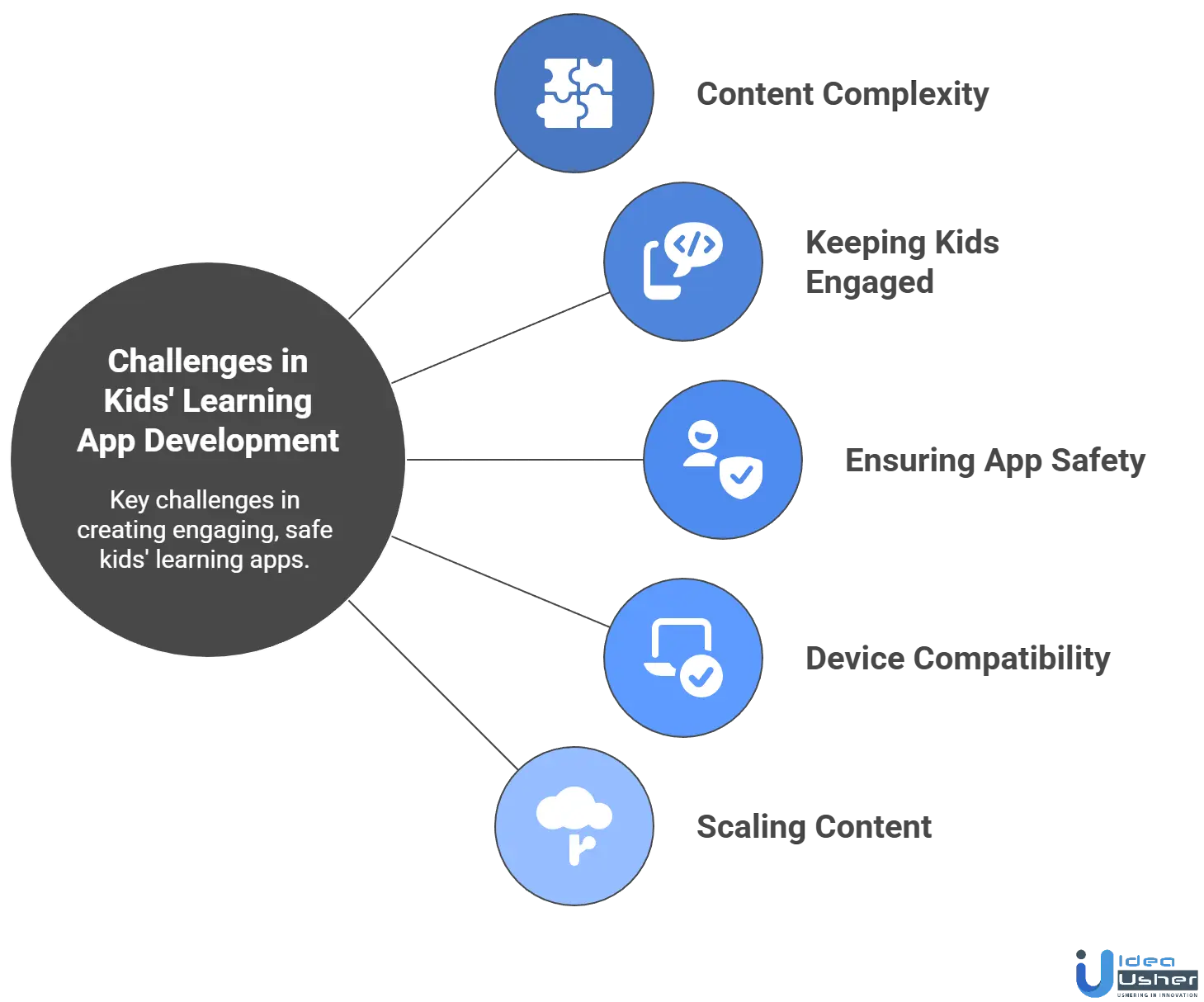
1. Content Complexity
Challenge: Designing educational content that is accurate, age-appropriate, and engaging can be difficult, especially when covering multiple skills like literacy, numeracy, science, and SEL.
Solution: We design content that simplifies complex learning ideas into playful activities for young children. Our developers use modular game frameworks to ensure lessons are consistent, scalable, and meet early-learning standards, supporting clear educational outcomes.
2. Keeping Kids Engaged
Challenge: Children lose interest quickly if games are repetitive, overly difficult, or lack interactive elements.
Solution: We build play-based learning experiences with interactive animations, short levels, and meaningful rewards. Our designers add character-driven storytelling and varied game mechanics to sustain engagement and encourage repeat usage.
3. Ensuring App Safety
Challenge: Kids’ apps must follow strict privacy rules and prevent exposure to ads, external links, or unsafe interactions.
Solution: We implement COPPA and GDPR-K compliant workflows, secure login systems, parental gates, and a fully ad-free environment. Our team minimizes data collection and maintains transparent privacy practices to earn parent trust.
4. Device Compatibility
Challenge: Children use a wide range of devices, including older tablets, school Chromebooks, and budget smartphones, making performance consistency challenging.
Solution: We optimize the app for low-end and diverse devices by compressing assets, refining animations, and conducting extensive multi-device QA testing. Our goal is to deliver smooth performance and fast load times everywhere.
5. Scaling Content
Challenge: Adding new games, themes, or skill modules becomes time-consuming without a scalable structure.
Solution: We build a centralized content management system (CMS) that allows our team to publish new games and updates quickly. Our developers use reusable components and templates to scale content efficiently while maintaining quality.
Conclusion
Building a strong foundation for kids’ gaming learning app like PBS Kids Games development comes down to creating an experience that feels playful, safe, and genuinely educational. When the content is interactive, age aligned, and supported by clear learning goals, children naturally stay engaged. Thoughtful features such as guided activities, easy navigation, and adaptive learning paths help parents feel confident in the value of the platform. With careful planning and the right approach to design and functionality, you can deliver an app that supports meaningful learning while keeping the experience fun and approachable for young users.
Why Choose IdeaUsher for Your Kids’ Learning App Development?
We design learning experiences that combine education with immersive gameplay. Our team builds apps that support early learning goals, include on brand characters, and offer a secure environment trusted by parents.
What Makes Us a Strong Development Partner?
- End-to-End Development: From content planning to app design, development, testing, and deployment, we deliver complete solutions.
- Child Centric Design: Our UI and UX decisions focus on how kids explore, learn, and interact with digital content.
- Content Integration: Whether you need STEM modules, literacy based games, or interactive puzzles, we help you design content that aligns with learning outcomes.
- Scalable Architecture: We build systems that support long term updates, new games, and expanding content libraries.
If you are looking to build a kids’ learning app that offers real educational value and long term market potential, our experts can help you shape, build, and launch it.
Reach out today for a consultation and see how we can bring your vision to life.
Work with Ex-MAANG developers to build next-gen apps schedule your consultation now
FAQs
An effective kids’ gaming learning app blends interactive activities with age appropriate content. It supports clear learning outcomes while offering a mix of visuals, audio cues, and guided tasks that help children understand concepts through play.
Offering varied activities such as puzzles, stories, quizzes, and creative tasks helps children stay engaged longer. It allows different learning styles to thrive and ensures the app supports a wide range of early skills, from literacy to reasoning.
Parent dashboards, usage insights, and progress tracking help adults stay aware of their child’s growth. This involvement strengthens learning outside the app and builds trust by showing that the platform supports consistent educational development.
Safety comes from secure logins, limited communication options, strict privacy practices, and COPPA-aligned data handling. These measures protect children while they explore the app and ensure parents feel confident about its use.












